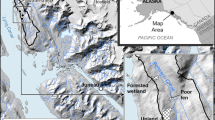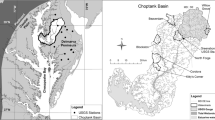Abstract
Storm event exports of dissolved \( {\text{NH}}^{ + }_{4} \) were explored for multiple events in the Point Peter Brook watershed (PPBW), a glaciated, forested watershed located in Western New York, USA. Investigations were performed across four catchments (1.6–696 ha) with varying topography and the extent of surface-saturated areas. While wetland and riparian waters were important sources of \( {\text{NH}}^{ + }_{4} \) during non-storm periods, throughfall and litter leachate were the dominant contributors of \( {\text{NH}}^{ + }_{4} \) during storm events. Ammonium concentrations in catchment discharge displayed a sinusoidal seasonal pattern with a maximum during early spring (March) and a minimum in late summer (August–September). Storm event concentrations of \( {\text{NH}}^{ + }_{4} \) in streamflow were much greater than baseflow values and showed a consistent temporal pattern with an increase in concentrations on the hydrograph rising limb, a peak at or before the discharge peak, followed by a decline in concentrations. Storm event patterns of DON were similar to \( {\text{NH}}^{ + }_{4} \) while the patterns of \( {\text{NO}}^{ - }_{3} \)differed from \( {\text{NH}}^{ + }_{4} \) for the summer and fall events. The storm event expression of \( {\text{NH}}^{ + }_{4} \) was attributed to throughfall and throughfall-mediated leaching of the litter layer. The reactive behavior of \( {\text{NH}}^{ + }_{4} \) precluded its use in an end member mixing model (EMMA) for predicting streamflow concentrations. While concentrations of \( {\text{NH}}^{ + }_{4} \) in precipitation and streamflow were high for the spring events, exports of \( {\text{NH}}^{ + }_{4} \) in streamflow were highest for the large and intense storm events. Baseflow \( {\text{NH}}^{ + }_{4} \) concentrations increased with the percent wetland/saturated area in the catchment but the same trend did not hold for storm-event concentrations.
Similar content being viewed by others
References
Aber, J. D., Nadelhoffer, K. J., Steudler, P. A., & Melillo, J. M. (1989). Nitrogen saturation in forest ecosystems. Bioscience, 39, 378–386.
Ameel, J. J., Axler, R. P., & Owen, C. J. (1993). Persulfate digestion for determination of total nitrogen and phosphorus in low-nutrient waters. American Environmental Laboratory, 10, 1–111.
Arheimer, B., Andersson, L., & Lepisto, A. (1996). Variation of nitrogen concentration in forest streams – influences of flow, seasonality and catchment characteristics. Journal of Hydrology, 179, 281–304.
Boyer, E. W., Hornberger, G. M., Bencala, K. E., & McKnight, D. M. (1997). Response characteristics of DOC flushing in an Alpine catchment. Hydrological Processes, 11, 1635–1647.
Burns, D. A., McDonnell, J. J., Hooper, R. P., Peters, N. E., Freer, J. E., Kendall, C., et al. (2001). Quantifying contributions to storm runoff through end-member mixing analysis and hydrologic measurements at the Panola Mountain Research Watershed (Georgia, USA). Hydrological Processes, 15, 1903–1924.
Burns, D. A., Murdoch, P. S., Lawrence, G. B., & Michel, R. L. (1998). Effect of groundwater springs on NO3-concentrations during summer in Catskill Mountains streams. Water Resources Research, 34, 1987–1996.
Christopherson, N., & Hooper, R. P. (1992). Multivariate analysis of stream water chemical data: the use of principal component analysis for the end-member mixing problem. Water Resources Research, 28, 99–107.
Creed, I. F., & Band, L. E. (1998). Export of nitrogen from catchments within a temperate forest: Evidence for a unifying mechanism regulated by variable source area dynamics. Water Resources Research, 34(11), 3105–3120.
Devito, K. J., & Dillon, P. J. (1993). The influence of hydrologic condition and Peat oxia on the phosphorus and nitrogen dynamics of a conifer swamp. Water Resources Research, 29, 2675–2685.
Driscoll, C., Whithall, D., Aber, J., Boyer, E., Castro, M., Cronan, C., et al. (2003). Nitrogen pollution in the northeastern United States: Sources, effects, and management options. BioScience, 53, 357–374.
Hill, A. R. (1993). Nitrogen dynamics of storm runoff in the riparian zone of a forested watershed. Biogeochemistry, 20, 19–44.
Hill, A. R., & Warwick, J. (1987). Ammonium transformation in springwater within the riparian zone of a small woodland stream. Canadian Journal of Fisheries and Aquatic Sciences, 44, 1948–1956.
Hill, A. R., Kemp, W. A., Buttle, J. M., & Goodyear, D. (1999). Nitrogen dynamics of subsurface storm runoff on forest Canadian shield hillslopes. Water Resources Research, 35, 811–824.
Hinton, M. J., Schiff, S. L., & English, M. C. (1998). Sources and flowpaths of dissolved organic carbon during storms in two forested watersheds of the Precambrian Shield. Biogeochemistry, 41, 175–197.
Hjerdt, K. N., McDonnell, J. J., Seibert, J., & Rodhe, A. (2004). A new topographic index to quantify downslope controls on local drainage. Water Resources Research, 40, W05602, doi: http://dx.doi.org/10.1029/2004WR003130.
Hornberger, G. M., Bencala, K. E., & McKnight, D. M. (1994). Hydrological controls on dissolved organic carbon during snowmelt in the Snake River near Montezuma, Colorado. Biogeochemistry, 25, 147–165.
Howarth, R. W., Billen, G., Swaney, D., Townsend, A., Jaworski, N., Lajtha, K., et al. (1996). Regional nitrogen budgets and riverine N and P fluxes for the drainages to the North Atlantic Ocean: Natural and human influences. Biogeochemistry, 35, 75–139.
Inamdar, S. P., & Mitchell, M. J. (2006). Hydrologic and topographic controls on storm-event exports of dissolved organic carbon (DOC) and nitrate across catchment scales. Water Resources Research, 42, W03421, doi: http://dx.doi.org/10.1029/2005WR004212.
Inamdar, S. P., & Mitchell, M. J. (Submitted-a). Landscape controls on storm event runoff generation across multiple catchments in a forested glaciated watershed. Journal of Hydrology.
Inamdar, S. P., & Mitchell, M. J. (Submitted-b). Storm event exports of dissolved organic nitrogen (DON) across multiple catchments in a glaciated forested watershed. Journal of Geophysical Research – Biogeosciences.
Inamdar, S. P., O’Leary, N., Mitchell, M. J., & Riley, J. T. (2006). The impact of storm events on solute exports from a glaciated forested watershed in western New York, USA. Hydrological Processes, 20, 3423–3439.
Lovett, G. M., Weathers, K. C., & Sobczak, W. V. (2000). Nitrogen saturation and retention in forested watersheds of the Catskill Mountains, New York. Ecological Applications, 10, 73–84.
McHale, M. R., Cirmo, C. P., Mitchell, M. J., & McDonnell, J. J. (2004). Wetland nitrogen dynamics in an Adirondack forested watershed. Hydrological Processes, 18(10), 1853–1870.
McHale, M. R., McDonnell, J. J., Mitchell, M. J., & Cirmo, C. P. (2002). A field-based study of soil water and groundwater nitrate release in an Adirondack forested watershed. Water Resources Research, 38(4), 2-1–2-16.
Mitchell, M. J., McGee, G. G., McHale, P., & Weathers, K. C. (2001). Experimental design and instrumentation for analyzing solute concentrations and fluxes for quantifying biogeochemical processes in watersheds. In Methodology paper series of the 4th international conference on ILTER in east asia and pacific region, Ulaanbaatar-Hatgal, Mongolia. 2001, pp. 15–21. ILTER Network.
Petry, J., Soulsby, C., Malcolm, I. A., & Youngson, A. F. (2002). Hydrological controls on nutrient concentrations and fluxes in agricultural catchments. The Science of the Total Environment, 294, 95–110.
Phillips, R. A. (1988). Relationship between glacial geology and streamwater chemistry in an area receiving acid deposition. Journal of Hydrology, 101, 267–273.
Pionke, H. B., Hoover, J. R., Schnabel, R. R., Gburek, W. J., Urban, J. B., & Rogowski, A. S. (1988). Chemical-hydrologic interactions in the near-stream zone. Water Resources Research, 24(7), 1101–1110.
Schiff, S. L., Devito, K. J., Elgood, R. J., McCrindle, P. M., Spoelstra, J., & Dillon, P. (2002). Two adjacent forested catchments: Dramatically different NO3-exports. Water Resources Research, 38(12), 1292, doi: http://dx.doi.org/10.1092/2000WR000170.
Schrumpf, M. (2004). Biogeochemical investigations in old growth and disturbed forest sites at Mount Kilimanjaro. PhD thesis, University of Bayreuth, Germany.
Stottlemyer, R., & Troendle, C. A. (1992). Nutrient concentration patterns in streams draining alpine and subalpine catchments, faser experimental forest, Colorado. Journal of Hydrology, 140, 179–208.
Welter, J. R., Fisher, S. G., & Grimm, N. B. (2005) Nitrogen transport and retention in an arid land watershed: influence of storm characteristics on terrestrial-aquatic linkages. Biogeochemistry, 76, 421–440.
Wigington, Jr P. J., Davis, T. D., Tranter, M., & Eshleman, K. N. (1990). Episodic acidification of surface waters due to acidic deposition, NAPAP Report 12, In Acidic Deposition: State of Science and Technology, National Acidic Precipitation Assessment Program, Washington, DC.
Wilcke, W., Yasin, S., Valarezo, C., & Zech, W. (2001). Change in water quality during the passage through a tropical montane rain forest in Ecuador. Biogeochemistry, 55, 45–72.
Author information
Authors and Affiliations
Corresponding author
Rights and permissions
About this article
Cite this article
Inamdar, S. Exports of dissolved ammonium (NH4 +) during storm events across multiple catchments in a glaciated forested watershed. Environ Monit Assess 133, 347–363 (2007). https://doi.org/10.1007/s10661-006-9589-7
Received:
Accepted:
Published:
Issue Date:
DOI: https://doi.org/10.1007/s10661-006-9589-7




